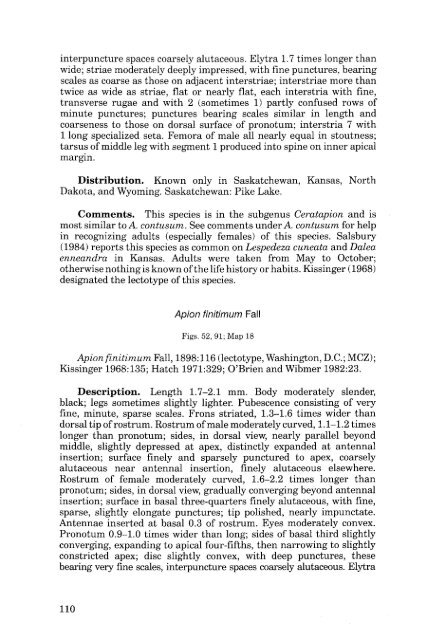Weevils - Entomological Society of Canada
Weevils - Entomological Society of Canada
Weevils - Entomological Society of Canada
You also want an ePaper? Increase the reach of your titles
YUMPU automatically turns print PDFs into web optimized ePapers that Google loves.
interpuncture spaces coarsely alutaceous. Elytra 1.7 times longer than<br />
wide; striae moderately deeply impressed, with fine punctures, bearing<br />
scales as coarse as those on adjacent interstriae; interstriae more than<br />
twice as wide as striae, flat or nearly flat, each interstria with fine,<br />
transverse rugae and with 2 (sometimes 1) partly confused rows <strong>of</strong><br />
minute punctures; punctures bearing scales similar in length and<br />
coarseness to those on dorsal surface <strong>of</strong> pronotum; interstria 7 with<br />
1 long specialized seta. Femora <strong>of</strong> male all nearly equal in stoutness;<br />
tarsus <strong>of</strong> middle leg with segment 1 produced into spine on inner apical<br />
margin.<br />
Distribution. Known only in Saskatchewan, Kansas, North<br />
Dakota, and Wyoming. Saskatchewan: Pike Lake.<br />
Comments. This species is in the subgenus Ceratapion and is<br />
most similar to A. contusum. See comments underA. contusum for help<br />
in recognizing adults (especially females) <strong>of</strong> this species. Salsbury<br />
(1984) reports this species as common on Lespedeza cuneetq and Dalea<br />
enrueandra in Kansas. Adults were taken from May to October;<br />
otherwise nothing is known <strong>of</strong> the life history or habits. Kissinger (1968)<br />
designated the lectotype <strong>of</strong> this species.<br />
Apion finitimum Fall<br />
Figs. 52, 91; Map 18<br />
Ap i o n fi ni t i m u m F all, 1 8 98 : 1 1 6 ( lectotype, Washin gton, D.C. ; MCZ) ;<br />
Kissinger 1968:135; Hatch l97l:329; O'Brien and Wibmer 1982:23.<br />
Description. Length L.7-2.1 mm. Body moderately slendeq<br />
black; legs sometimes slightly lighter. Pubescence consisting <strong>of</strong> very<br />
fine, minute, sparse scales. Frons striated, 1.3-1.6 times wider than<br />
dorsal tip <strong>of</strong> rostrum. Rostrum <strong>of</strong> male moderately curved, 1.1-1.2 times<br />
longer than pronotum; sides, in dorsal view, nearly parallel beyond<br />
middle, slightly depressed at apex, distinctly expanded at antennal<br />
insertion; surface finely and sparsely punctured to apex, coarsely<br />
alutaceous near antennal insertion, finely alutaceous elsewhere.<br />
Rostrum <strong>of</strong> female moderately curved, 7.6-2.2 times longer than<br />
pronotum; sides, in dorsal view, gradually converging beyond antennal<br />
insertion; surface in basal three-quarters finely alutaceous, with fine,<br />
sparse, slightly elongate punctures; tip polished, nearly impunctate.<br />
Antennae inserted at basal 0.3 <strong>of</strong> rostrum. Eyes moderately convex.<br />
Pronotum 0.9-1.0 times wider than long; sides <strong>of</strong> basal third slightly<br />
converging, expanding to apical four-fifths, then narrowing to slightly<br />
constricted apex; disc slightly convex, with deep punctures, these<br />
bearingvery fine scales, interpuncture spaces coarsely alutaceous. Elytra<br />
110

















